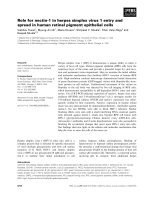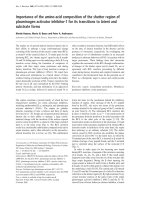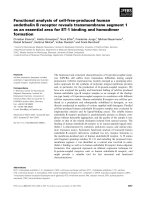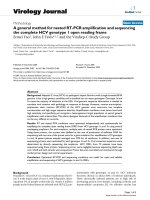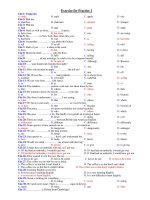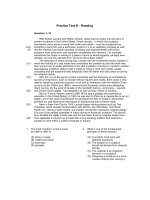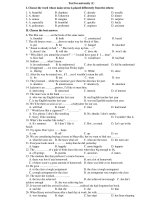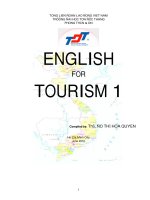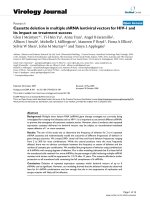Timed Reading For Fluency 1 -- Paul Nation And Casey Malarcher -- 2017 -- 9781946452672 -- 5832Ca3Ef93Bd072A63A6F3A78D9A8B9 -- Anna’s Archive (1).Pdf
Bạn đang xem bản rút gọn của tài liệu. Xem và tải ngay bản đầy đủ của tài liệu tại đây (8.67 MB, 112 trang )
Paul Nation / Casey Malarcher
Digitized by the Internet Archive
in 2023 with funding from
Kahle/Austin Foundation
/>
ned Reading
for Fluency
"
2
i
i
4
7
1
os
:
:
1
>
——
—
:
_
7
.
;
Timed Reading for Fluency 1
Paul Nation / Casey Malarcher
© 2017 Seed Learning, Inc.
7212 Canary Lane,
Sachse, TX, USA
All rights reserved. No part of this book may be reproduced, stored in
a retrieval system, or transmitted in any form by any means, electronic,
mechanical, photocopying, recording, or otherwise, without prior
permission in writing from the publisher.
Acquisitions Editor: Kelly Daniels
Content Editor: David Charlton
Copy Editor: Andrea Janzen
Design: Highline Studio
The authors would like to acknowledge Kelly Lee, Randy Lewis, and Joy
Yongo for contributing material to this book.
ISBN: 978-1-9464-5267-2
10987654
Jip 72\\ 7X0) iN)
Photo Credits
All photos are © Shutterstock, Inc.
Introduction
Ko“
/6
xer
oA
Nature
Reading 1
Dolphins Talk / 11
Reading 2
Levels in Nature
Reading 3
A Dangerous Wind
Reading 4
A Hard-Working Plant / 17
Reading 5
Lost Forever?
ED,
SS
/ 13
/ 15
/ 19
Nhe
Music
Reading 6
Fun and Games and Music / 23
Reading 7
That Can Make Music? / 25
Reading 8
Healthy to Hear / 27
Reading 9
Music That Stays in Your Head
Reading 10
Only Voices
/ 31
er
° 3) Health
er
WES
Reading 11
Sleep—You Need It! / 35
Reading 12
Doctor Trees
Reading 13
Blood Work
Reading 14
Are You Under Stress?
Reading 15
Getting Vitamin D / 43
Sy
<é
4.
=
Education
/ 37
/ 39
/ 41
/45
Reading 16
Artin the Classroom
Reading 17
Does Homework Help? / 49
Reading 18
How to Take Notes
/51
Reading 19
A Part of Learning
/ 53
Reading 20
Private vs. Public Schools
/ 47
/ 55
/ 29
oe
er
S 5
ad
Business
Reading 21
A Job for Everyone?
Reading 22
The Work Week
Reading 23
Desks at the Office / 63
Reading 24
Brands and Colors /65
Reading 25
Who Ownsa
/59
/ 61
/67
Song?
/69
ot
Reading 26
Insects Are Good
/71
Reading 27
GreenTea
Reading 28
Waste Not /75
Reading 29
Marmite
Reading 30
The Hotter, the Better / 79
Reading 31
Start Your Engines!
Reading 32
Cup Stacking
Reading 33
Kicking for Fun
Reading 34
Believe lt or Not /89
Reading 35
The No-Sweat Sport /91
/ 73
/77
/ 83
/85
/ 87
er
“8
People
/ 93
Reading 36
Go, Marta!
/95
Reading 37
William’s Windmills
Reading 38
Making Beautiful Music
Reading 39
AnInternet Star / 101
Reading 40
Bornto Bethe Same?
Reading Speed Chart " WAtS
/ 97
/ 99
/ 103
Introduction
A well-organized language course provides opportunities for learning through communicative
activities involving listening, speaking, reading and writing, deliberate study, and fluency
development. The fluency development part of a course should take about one-quarter of the course
time, and there should be fluency development activities for each ofthe four skills of listening,
speaking, reading, and writing.
This series of books focuses on fluency in reading. Fluency involves making the best use of
what you already know. That comes from working with familiar vocabulary and grammar, and from
practicing using them in a comfortable way without having to struggle.
Four Requirements of Fluency Development:
1. Familiar Material
Material for fluency development must be
known and familiar. It should not involve
unfamiliar language items or content too far
removed from what learners already know.
This is because to become fluent, learners
need to focus on using material they already
know well, not on learning new vocabulary or
grammar. This is why the texts in these books
are grouped into topic areas so that learners
can read several texts about very similar
information. Their familiarity with the topic
will help them increase their reading speed.
Learners do not get fluent in reading by
struggling through difficult texts with lots
of unknown words. The books in this series
are carefully written within a controlled
vocabulary so that there is a minimum
of unknown words. Words that might be
unfamiliar to some learners are dealt with
before the reading texts.
2. Quantity of Practice
Another key requirement of a
fluency development course
is quantity of practice. Fluency
develops by doing plenty of
practice with easy material. That
is why each book in this series
contains a lot of reading texts.
When learners have finished
working through one book in
the series, it is a good idea if they
go back over the texts they have
already read, trying to read them
faster than they did the first time.
3. Pressure to Go Faster
A fluency development course will work well if there is some pressure to go
faster when using the language. This series of books uses timed readings.
When the learners read, they measure how long it takes them to do the
reading, and they keep a record oftheir reading speed. Their aim is to
increase their speed until it gets close to 250 words per minute. The upper
limit of reading speed is 300 words per minute. Reading faster than that
requires skipping words on the page and relying on background knowledge
to fill the gaps. While this is a useful reading skill, it does not help develop
reading fluency in a second language.
ff ce
4. A Focus on Comprehension
Fluency in reading not only involves speed
of word recognition, but also involves
comprehension. This is why the texts in
these books are followed by questions.
There is no value in reading faster if there is
a big drop in comprehension.
At the back of each book there is a graph
BBE
BLES
Eee
ARAB
Ee*VElsje/slels|*
where learners should enter their reading
speed for each text and their comprehension
~ score. The learners’ goal should be to make
their reading speed graph keep going up.
ie WV
Nature
Look at the pictures. Write the right words.
Aloe vera //
careful v
Dolphins 7
scientist
smart /
suddenly,
health
a
Tornadoes 1
hit trees
3. Some people use Aloe
their
Weal
|
plants for
4. The
<
falas
writes _
notes about an animal he sees.
Chapter 1: Nature
9
|B Match the meaning with the right word.
il. re
2.
a. cloud
very quickly; without warning
b. breathe
2 __ knowing alot; intelligent
d. suddenly
howgood or bad your body is
4. ©
5.)
c. health
abig white thing in the sky
3. 4
e. smart
to make air go into and out of the body
Work with a classmate. Think about things in nature. Write two ideas for plants or
animals that...
1. ...can be used for one’s health.
2. ...are able to breathe in water.
3. ...are dangerous, so you must be careful near them.
4, ... won't be hurt when a tornado hits.
LD
Read about different plants and animals. Write the right word in each blank.
Raintrees
1. Alc
Vea
* are green
Aloe Vera
2. (van
DA PMIWS
Bluebirds
3,
Li
River Dolphins
eb
A. |
¢ can be eaten
* are not common
around the world
* look for food
during the day
* grow in South
America
¢ have a chemical
that is good for our
skin
¢ breathe air
* swim in lakes and
rivers
* can sing
* lay blue eggs
* close their leaves at
night
10 Chapter 1: Nature
* have nice wood for
furniture
Scientists put a mother in one place. They
put her two-year-old child in another place.
There was a telephone line between them. Soon,
the mother and child were talking to each other.
The mother and child were dolphins.
In this test, one of the two dolphins would make
_a sound. Then the other dolphin would make the same sound.
Also, the scientists believed that the two animals knew who they were talking to.
Scientists have known for a long time that animals can “talk” with each other. But
dolphins have a special way of talking. And they are very smart. When they are in a group,
they “talk” to each other. They do this using different sounds. Scientists have listened to
the dolphins’ sounds, and they have watched the dolphins. They now believe that the
dolphins really are talking. They just don’t know what the dolphins are saying.
Dolphins not only use sounds. They use body language, too. They “tell” something
to another dolphin by moving their body in a special way. They also do it by opening and
closing their mouths quickly.
Scientists hope to understand dolphin language. They want to learn more about
these very interesting animais.
Word Count
200 words
Reading 1: Dolphins Talk 11
Comprehension Questions
Circle the right answer.
1. This reading is about
a. dolphins that talk to people.
b) dolphins that talk to each other.
c. dolphins that talk to fish.
2. Scientists believe that the mother dolphin and her baby
a. were just making noise.
b. were talking about other dolphins.
‘c,/ knew who they were talking to.
3. Which of these is NOT a way dolphins talk?
a. By using their bodies
(b. By using other fish
c. By using sounds
4. Dolphins are special animals because
a. they can “talk” to other animals.
“b, they have a special language.
c. they understand human speech.
5. Besides using sounds to “talk,” dolphins tell things to each other by
a. pushing water quickly or slowly.
b. playing with rocks and sand in the sea.
c,/opening and closing their mouths.
Ge»
Extra Practice
Circle True or False for each sentence.
1. A dolphin can swim.
True)
False
2. Only people use language.
True
False-
3. Scientists have studied dolphins.
True
False
4. Body language uses words.
True
‘False?
5. Some animals are smart.
True’
False
12 Chapter 1: Nature
Animals get energy from the things that they eat. Some animals eat plants. Some eat
other animals. Some eat plants and other animals. By looking at what eats what, we can
learn how energy moves from one living thing to another.
One way to look at how energy moves from animal to animal is to imagine three
levels in nature. At the first level, plants and trees make their own food. Animals and
insects are usually in the second level. These are living things that eat things from the first
level. Sometimes, they eat things from the second level, too. Some animals eat plants, and
then another big animal eats them. Very small animals that you can’t even see are part of
the third level. After a living thing dies, these very small animals break down its body.
We can imagine something like
a
these three levels in the ocean, too.
Some kinds of small sea life use the
kind of small sea life eats them. A
fish then eats the small sea life, and
something larger eats the small fish.
So energy moves between animals in
the ocean just like it moves on land.
Word Count
Wa)
wn
200 words
(=)
Reading 2: Levels in Nature
13
Comprehension Questions
Circle the right answer.
1. This reading is about
a. things to eat in the ocean.
(b.) how energy moves in nature.
c. which animals eat plants.
2. Which of the following is true of the first level?
a. The animals there have very little energy.
b. All animals there are very small.
‘c.) Things there make their own food.
3. The writer says that animals and insects
a. are found in the first level.
‘b) are found in the second level.
c. are found in the third level.
4. In the third level, very small animals
a. eat only one kind of small sea animal.
b. need sunlight to make the food they eat.
‘c} break down the bodies of animals that die.
5. The writer says that in the ocean, energy moves
a. more slowly than it does on land.
(b) in the same way as it does on land.
c. from large animals to small animals.
Gen
Extra Practice
Circle the right word.
We can study how 1. Gee! ife) moves in nature by looking at what eats what.
An easy way to look at this is to 2. (
ine / learn) three levels in nature. The first level
has things that make their own aa in it. The second level has 3. ((insects / scientists)
and animals that eat things in the first and second levels. The third 4. (food / level) has
very small animals that break Bod the bodies of things after they die. These three
levels are the same in the 5. ((ocean / plants) as they are on land.
14 Chapter 1: Nature
A Dangerous Wind’x
a
In some parts of the world, wna! dark clouds fill the sky, a great danger
sometimes appears. This danger is a quickly turning tower ofair called
a tornado, and it is one ofthe most dangerous things in nature.
>
“cer
Tornadoes happen mostly’in the US, and they usually
5
en
form in the summer een wa rm, wet air and cold, drry
Fs
air meet. They appear at the bottom of large, dark
Pe
—
pple
nO
nia
F
Ts ,
clouds. The wind under the cloud begins to go around
i
~(
and around. It gets faster and faster and can become very
strong and dangerous. When the wind touches the ground,
10
a
nnn
seem
©itis calleda tornado. The turning tornado moves along the
ground and can break down trees and buildings in its way.
Most tornadoes are mal and only stay on the ground a
\ncl
Dan?
few minutes. However, even a small tornado can do a lot of sels
Sometimes, tornadoes are very, very big and can last much longer. The
Vo
is
worst tornado ever traveled 352 km and was on the ground for three and a
roan
half hours. Over 600 people died.
Tornadoes are so dangerous because they appear suddenly. There is often
=~,"
no time to run and no place to hide from them.
Word Count
,
oN
200 words
Reading 3: A Dangerous Wind
15
}
—
Comprehension Questions
Circle the right answer.
‘1. This reading is about
a. dark clouds.
b. rain storms.
c.)tornadoes.
2. Which of these is NOT needed to form a tornado?
Gq Rain
b. Warm, wet air
c. Cold, dry air
3. What does the wind in a tornado do?
a._It goes in a straight line.
(béItgoes around and around.
c. It goes up and down.
4. Tornadoes are so dangerous because
a. they are always very big.
b. they stay on the ground a long time.
\C/ they appear suddenly.
5.
How far did the worst tornado travel?
a. About one kilometer
. Less than ten kilometers
| P)Over three hundred kilometers
GE»
Extra Practice
Circle True or False for each sentence.
1. A tornado is made of quickly turning air.
True
2. Tornadoes appear at the bottom of large dark clouds.
True False
3. In the worst tornado ever, 60 people died.
True
False
4, Many tornadoes only stay on the ground for a few hours.
5. Tornadoes are dangerous because they appear suddenly.
True.
False
16 Chapter 1: Nature
False
Tee False
S\
¢
W
\
)
Many people have Aloe vera plants in their homes. People have been growing Aloe
MiUes
vera for thousands of years. People used Aloe vera to help with health problems as long
ago as 2100 BCG
Gow
io >)
Aloe vera is a olen that is ie found in hot, dry places. It has long, green leaves,
(-
5
and it is a very hard--working plant. Itcan be used to help with cuts or burns. Aloe vera also
Yar
A })
cleans the air around it. Bad air can come from the paint on the walls of some houses. Aloe
vera can make the air clean again. Aloe vera is alse a good plant to JENSin your room at
WA WD
Wd
&
night when you sleep. It takes in the air you precine out. The plant eit gives off clean air
that you breathe in.
10
Growing an Aloe vera plant at home
is very easy! You can buy a plant at Ba me
store. Put it in a place where there is plenty
of sunlight. Water your plant during the
spring, summer, and fall. If you want more
is
Aloe vera plants, you can just Break off part
of the Aloe vera plant. You can put this in
the ground to grow again.
Word Count
200 words
Reading 4: A Hard-Working Plant 17
Comprehension Questions
Circle the right answer.
1. This reading is about
a. how Aloe vera works hard.
b. how Aloe vera gives off bad air.
c. how Aloe vera was used long ago.
2. Which of the following is NOT something that Aloe vera does?
a. Gives off something bad like paint
b. Gives off the air you breathe in
c. Helps with health problems
3. People have been growing Aloe vera
a. to use as a kind of paint.
b; for thousands of years.
c. as something to kill insects in their rooms.
4. You can grow more Aloe vera plants by
a. giving special plant food to the Aloe vera plant.
b. breaking off a part of the plant and planting it.
c. giving the plant a lot of water.
5. The writer says that Aloe vera is good to have in your room because
a. it will change colors to let you know you have a health problem.
b. when you break off a part of the plant, it does not hurt the Aloe vera.
c, it takes in the air you breathe out and gives off the air you breathe in.
Extra Practice
Gap
Circle the right word.
People like to grow Aloe vera plants in their homes. One thing that these plants
are good for is your 1. (health /touch). You can use these plants to help with cuts or
Zs (burns / walls). Aloe vera are also good because they clean the air you
oh (breathe / dry). These plants are easy to grow. Just put a piece of the plant in the
ground in a place where it can get 4. (clouds / plenty) of sunlight. Give it water in the
5. (spring / wind), summer, and fall, and it will grow well!
18
Chapter 1: Nature
People live all over the world. But they are not always very careful about how they
live. People can cut down too many trees or put bad things into the water. This can hurt
the plants, trees, and animals that live there. Sometimes, one kind of animal or tree dies out
and is gone forever. But not all of these animals or trees are gone forever. Some seem to be
gone and then suddenly they come back!
This can happen to animals, plants, or trees. For a long time we think that they are
gone. Since they are not seen for a long time, scientists say they have died out. Then
someone finds one—or many! Scientists once said that one type of bird that could not fly
was no longer living anywhere in the world. Then, in 2013, someone saw one! The bird that
could not fly was still there. This was good news. It shows us that there are many things we
do not know about our world. It also shows us that we need to be careful about how we
live. We need to take care of our world so that living things are not gone forever.
Word Count
200 words
Reading 5: Lost Forever?
19
Comprehension Questions
Circle the right answer.
1. This reading is about
‘a? animals and plants that seem to be gone and then come back.
b. plants and animals that are gone forever, and people like that.
c. scientists who seem to have discovered new animals in nature.
2. What does the writer say about animals that are gone forever?
“a Notall of the animals are really gone forever.
b. There is more room for people because they are gone.
c. Other animals must change once an animal is gone.
3. The writer says that
a. people should put good things in the water.
b. people should find more animals near cities.
c, people should take care of the world around them.
4. Atone time, scientists thought that
a. birds made one kind of tree die out.
(? a bird that could not fly was no more.
c. when animals suddenly come back, it is bad news.
5. The writer says that people sometimes hurt
a. the animals living in people’s homes.
b. only large animals, but not small animals.
og both plants and animals.
GE
Extra Practice
Circle True or False for each sentence.
20
1. People are always careful how they live.
True
False
2. Scientists say something has died out if no one sees it for a week.
3. Sometimes one kind plant or animal dies out and is gone forever.
4. Sometimes one kind of plant or animal seems to be gone, but it isn’t.
True
False)
True)
False
True
False
5. A type of bird that was thought all gone was seen in 2013.
True
False
Chapter 1: Nature
LAL Look at the pictures. Write the right words.
advertisement
CD
computer
people
pipes
record
toys
video
Things that can make music:
When you might hear music:
playing a(n) 8.
Chapter 2: Music
21
|B Write the right word in each blank.
advertisement
beans
affect
exciting
pain
pipe
pizza
records
reason
videos
_not through CDs or
1. Most people today listen to music through
, but never
3. Someone might order extra cheese on top of their
the sound that it makes when you hit it.
will
4. The size of the
, but we still don’t know what it
TV
5. We enjoyed watching the
was advertising.
LC
in his
my grandfather takes medicine every day is for the
Zone
legs.
Survey your classmates. Write the name of one person who...
1. ...can sing an advertisement from radio or TV.
... listens to music when exercising or working out.
2
3
.. has CDs with music on them at home.
4. ... watched an exciting band play live on stage.
5
|D
.. was SO affected by a song that it made him/her cry.
Complete the chart with words from the box.
computer
record
exciting
|
il
||
reason
shake
advertisement
—_Adjectne
record
recorded
excitement
excite
a
a
compute
computed
4.
advertise
advertised
shaker
5,
shaken
6.
z
ie
_ reason|
reasonable
Proper Nouns to Know
Study these words that you will find in the readings for this chapter.
22 Chapter 2: Music
|
Some people may not like video games. But they might like the music from some
games! The pictures and story are a big part of why most people like video games. The
music helps tellthe game's story.
The first video games had simple sounds or music. However, computers became
faster and better. The music also got better. The sounds in a game are now very important.
They help you feel like a part of the story.
A lot of music in the games makes you have a special feeling. Many times, the music
is exciting. This happens when you win the game or get more points. But it can also be
very soft, or it can make you fel aival! Much of the music is played very well. This is a big
reason why people who usually do not like video games do like some of them: it’s because
of the music. They enjoy the sound of the nice music.
You can buy a CD with video game music onnit to fae to at home or in the car. You
do not have to be in front of a computer to enjoy the sounds of your favorite game!
Word Count
200 words
Reading 6: Fun and Games and Music
23
